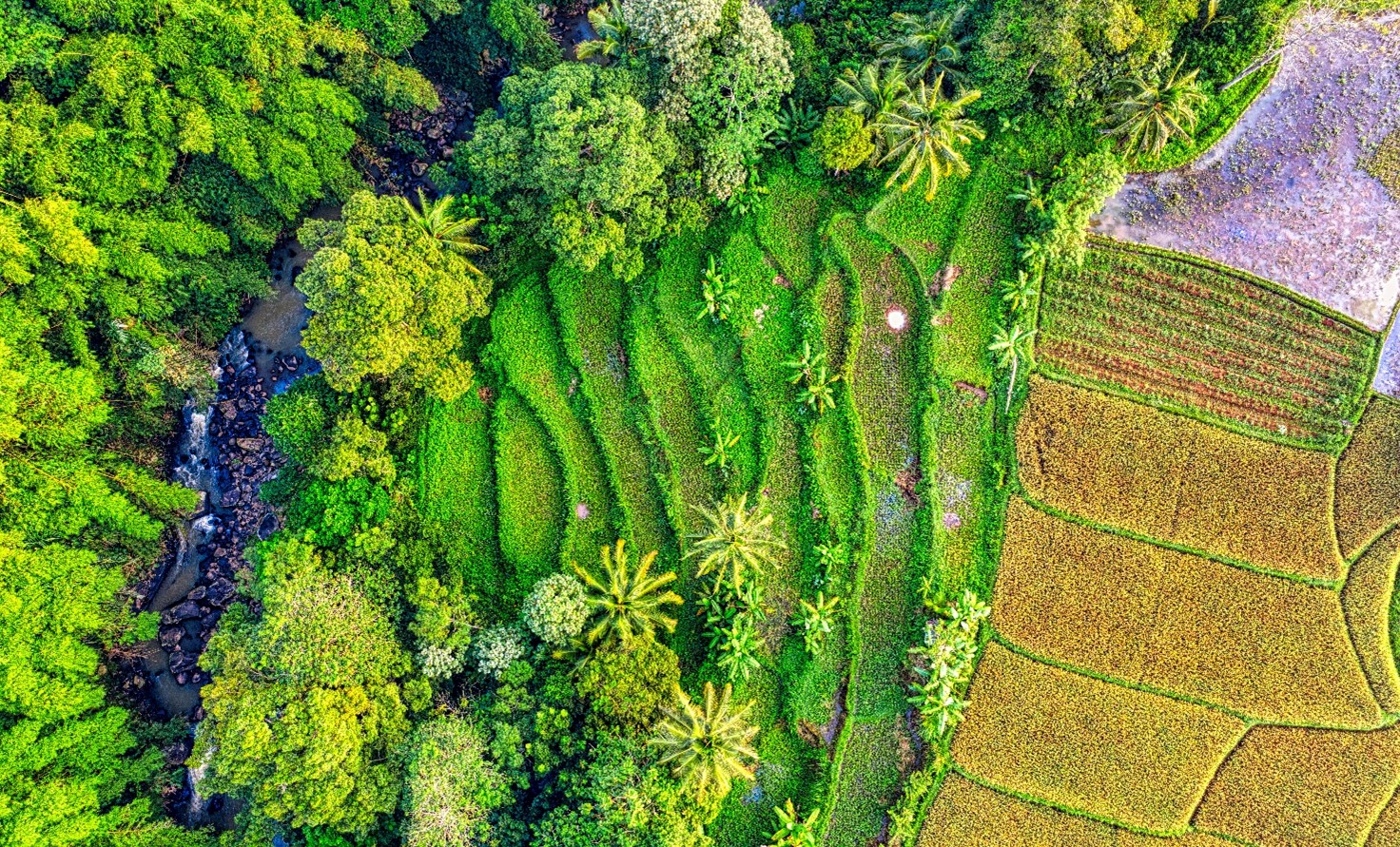Plant Cover and Soil – Water Conservation

This post is also available in:
This post is also available in:
![]() Français (French)
Français (French) ![]() Deutsch (German)
Deutsch (German) ![]() हिन्दी (Hindi)
हिन्दी (Hindi) ![]() العربية (Arabic)
العربية (Arabic) ![]() Türkçe (Turkish)
Türkçe (Turkish) ![]() 简体中文 (Chinese (Simplified))
简体中文 (Chinese (Simplified)) ![]() Português (Portuguese (Brazil))
Português (Portuguese (Brazil))
Vegetative soil conservation
Good protective cover near the soil surface early in the growing season of crops is important for soil and water conservation – at least in stripes across the slope, at steep slopes, under tall trees and along streams.
Plant cover is essential for soil and water conservation and can be efficient even against wind erosion. It can protect the soil surface directly, e.g., against heavy energetic rain drops, help water infiltration and stabilize particles that start to move. Also, increased plant cover can gradually increase soil organic matter stabilizing soil aggregates and biological activities and improving soil aggregate stability and water infiltration and absorption. Biological activity can stabilize aggregates soil with roots, slimes, and fungal hyphae and create pores in the ground. It largely depends on food sources like plant residues. However, to be effective, enough of the cover should be near the soil surface and present during the seasons near the seeding season with low plant cover. Cover of dead plants (litter) can help too. More nutrients and intensive management can mean more plant growth and biological activity, but high levels of phosphate compared to adequate can reduce the growth of fine roots and root-extending symbiotic mycorrhizal fungi. Likewise, more weed control may reduce the total biomass over the year without a cover crop.
Establishing enough plants is vital for early plant cover, germination, emergence, and early growth rate. Low irregular germination can be due to late land preparation, damaged seed, poor contact between the seed and soil below, too deep or too shallow sowing, compacted or hot soils, etc. Seed eaters, slow growth after germination or unsuited weather. Plants that are grown mainly to contribute to soil conservation and improvement often have seeds that differ a lot from what farmers are generally used to. The new multipurpose seeds may be smaller (or bigger), needing adjusted seeding depths. See also the subsection below.
Wild legumes (‘bean plant family’) are often used in mixes with other cover crops. Such species can also help by fixing nitrogen from the soil air (N2) to eroded soils so plants can use it in the form of ammonium and nitrate nitrogen. Mature, dry seeds will often be unable to absorb water into the hard, smooth, impermeable seed coat or their few small and sealed pores without suitable pre-treatment. It is one type of seed coat or one hard seed dormancy. Hot water may open a few small pores for water uptake over some days but may kill the vital germ in the seed. Seeds’ needs and tolerance can vary with maturity, moisture content, genetic type, etc. Mechanical damage by at least one scratch through the outer seed coat works, and results can be seen after a few seconds or minutes soaked in water (extra coarse sandpaper, sanding machines, or pressing with a shoe against worn concrete can be used, Mandal (e.g. 2010).
Some are treated in rotating drums at the seed suppliers. Electrical sanding-papers tools can be used too. Hot water may help the water uptake slowly via a few small pores or kill the seeds. Boiling water for 3 seconds or 80 oC hot water for 3 minutes or 60 oC left to cool down under cover may be tested first and adjusted after observing for 3 – 7 days in a plate with water. Without a thermometer, the following methods can be used: 3 to 1 volume ratio of 100 oC and 20 oC give 80oC. 100 oC and 20 0C in 1:1 ratio gives 60oC. Water stored at room temperature will often be about 20 oC. Guidelines are often risky to use or with little or no effect so trying locally after storing the seed is useful.
Sulfuric acid can be used too, but it can be risky for people and the germ, and it is hard to standardize because getting a visible superficial impact on the surface is not always enough. Guidelines are often unreliable, and testing after storage (drying) is advisable. Deep scratching between two layers of extra coarse sandpaper resulting in swelling can be the reliable gold standard to compare with faster methods. Soaking a seed sample in unheated water can help test whether pre-treatment is needed for early (or slow) germination. Timing of germination is important for management, droughts, and competition.
See more under Mandal (2010) or the agroforestry section by Mandal – e.g., on improved low-input methods.
Seeding or planting in rows across the wind direction or the slope can help against erosion and water loss. It can be done both for the harvested main crops, and for other plants (grass, wild herbs, shrubs, and/or trees) used to protect soil, water, and nutrients. Likewise, simple unploughed strips with spontaneously emerging plants across the direction of erosion can help.
Stripes with permanent vegetation can also give protection and feed predators, which are eating harmful pests, that quickly could multiply in seasonal crops. The crop eaters-pests are usually simpler and faster multiplying than their natural enemies. Nectar from flowers helps feed several young beneficial insects including insect-eating types. Figure 1, left and mid.

Figures 1. Protective soil surface cover. Relatively narrow (left) or broad (mid) grass stripes can reduce water runoff and erosion. Nitrogen-fixing legumes incl. trees may be needed particularly if nutrients are removed as fodder. Other plants can also be used if low cover of the surface is kept in stripes at the season with most erosion. Early soil cover near the surface among the crops is also important. Dead plant materials (often called mulch or litter) help too (right). Likewise, stones can be used. From Kenya in Muriuki & Macharia (2011).
Dead plant materials covering the surface (litter, mulch) can also stop erosion if enough is available near the surface. However, it can be hard to get enough; some rot fast while others, like Eucalyptus leaves, may stay intact and be flushed or blown away. Snakes, rodents, wildfires, insects, and scraping poultry, that are killing seedlings, can also be a problem with mulch layers. They can reduce evaporation from the soil surface and cool it, but rain may not be effective in reaching roots. A soil surface without live plants soon gets too dry to suck more water up quickly (by capillary water movement) unless it has big clods and gaps. Drying by random diffusion of individual water vapour molecules is much slower than suction and other mass movements.
Timing seeding of cover and intercrops. Sowing cover crops or intercrops can be combined with weeding or ridging if seeding after the first seeding is best. It can help the first crop to establish with less competition, and suited rows across the slope may be enough to stop erosion. An ox-plough can be tilted to form ridges, or quick rough tractor tillage can leave the surface rough, so water usually neither runs across the furrows.
Extending the time of crop cover. Another way to reduce competition is using a cover crop or intercrop that develops deep roots before the top gets big, and the top can later grow much after the main crop, or the first crop, is harvested. Seeding before or after harvesting can also be possible. Even mechanized seeding between residues or cover crops can be possible with suitable machines.
Multipurpose use of soil protecting plants and dense, early plant cover can help soil and water conservation. Both early and long-term benefits and costs matter to farmers. Earlier and good crop cover can:
– suppress or solve weeds challenges,
-feed and shelter natural enemies of crop pests,
– reduce nitrogen and potassium leaching,
-increase biological nitrogen fixation,
-conserve phosphate and other nutrients on the soil surface,
– improve soil structure and water infiltration (but transpiration can increase), and
– improve root growth, soil organic matter, and microbial activity.
Some cover crops can be used as fodder or food. Combining different plants can help establish cover near the soil surface earlier and for a longer time. Such combinations can also add value to protected land; see more in the article about intercropping and agroforestry. To prevent water pollution, mainly with nitrate, it is illegal in, e.g., Denmark to leave soil bare more than necessary.
References
Baumhardt RL, and Blanco-Canqui H 2014 Soil: Conservation Practices. In: Neal Van Alfen, editor-in-chief. Encyclopedia of Agriculture and Food Systems 5, Elsevier, 153-165.
Hudson W N 1987 Soil and water conservation in semi-arid areas. Silsoe Associates Ampthill, Bedford United Kingdom. Soil Resources, Management and Conservation Service. FAO Land and Water Development Division. Food and Agriculture Organization of the United Nations Rome, 1987 https://www.fao.org/3/t0321e/t0321e00.htm
Land and Water Division 2000 Manual on Integrated Soil Management and Conservation Practices. FAO land and water bulletin Series number: 1024-6703. 214 pp. ISBN: 9251044171 https://www.fao.org/publications/card/en/c/31f117c4-13e2-5631-bf16-ebaaa10b714f
Muriuki JP, Macharia PN 2011 Green Water Credits Report K12: Inventory and Analysis of Existing Soil and Water Conservation Practices in Upper Tana, Kenya. https://www.isric.org/documents/document-type/green-water-credits-report-k12-inventory-and-analysis-existing-soil-and Open access.
Mandal T. 2010. Low-cost soil and water conservation with many early benefits. Presentation Researchers’ Day: Climate Change Impact, Adaptation and Mitigation GEUS, Inst. of Geography, University of Copenhagen. 7 October 2010. Arranged by the Climate Change Task Force. https://www.yumpu.com/en/document/view/35209735/present-danish-water-forum
Thomas DB et al. 1997. Soil and water conservation manual. Soil and Water Conservation Branch, Min. Agric. Livestock Dev. and Marketing, Nairobi Kenya.
Watene G and others 2021 Water Erosion Risk Assessment in the Kenya Great Rift Valley Region Sustainability 2021, 13(2), 844; https://doi.org/10.3390/su13020844









































































